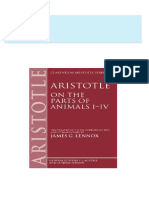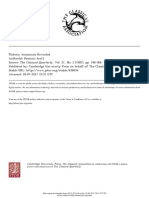Antisthenes: 2 Philosophy
Antisthenes: 2 Philosophy
Uploaded by
Valentin MateiCopyright:
Available Formats
Antisthenes: 2 Philosophy
Antisthenes: 2 Philosophy
Uploaded by
Valentin MateiOriginal Description:
Original Title
Copyright
Available Formats
Share this document
Did you find this document useful?
Is this content inappropriate?
Copyright:
Available Formats
Antisthenes: 2 Philosophy
Antisthenes: 2 Philosophy
Uploaded by
Valentin MateiCopyright:
Available Formats
Antisthenes
2 Philosophy
For other people named Antisthenes, see Antisthenes
(disambiguation).
Antisthenes (/ntsniz/;[1] Greek: ; c.
445 c. 365 BC) was a Greek philosopher and a pupil
of Socrates. Antisthenes rst learned rhetoric under
Gorgias before becoming an ardent disciple of Socrates.
He adopted and developed the ethical side of Socrates
teachings, advocating an ascetic life lived in accordance
with virtue. Later writers regarded him as the founder of
Cynic philosophy.
Life
Antisthenes was born c. 445 BC and was the son of Antisthenes, an Athenian. His mother was a Thracian.[2] In
his youth he fought at Tanagra (426 BC), and was a disciple rst of Gorgias, and then of Socrates, at whose death
he was present.[3] He never forgave his masters persecutors, and is said to have been instrumental in procuring their punishment.[4] He survived the Battle of Leuctra (371 BC), as he is reported to have compared the victory of the Thebans to a set of schoolboys beating their
master.[5] Although one source tells us that he died at the
age of 70,[6] he was apparently still alive in 366 BC,[7]
and he must have been nearer to 80 years old when he
died at Athens, c. 365 BC. He is said to have lectured
at the Cynosarges,[8] a gymnasium for the use of Athenians born of foreign mothers, near the temple of Heracles.
Diogenes Lartius says that his works lled ten volumes,
but of these, only fragments remain. His favourite style
seems to have been dialogues, some of them being vehement attacks on his contemporaries, as on Alcibiades in
the second of his two works entitled Cyrus, on Gorgias
in his Archelaus and on Plato in his Satho.[9] His style
was pure and elegant, and Theopompus even said that
Plato stole from him many of his thoughts.[10] Cicero, after reading some works by Antisthenes, found his works
pleasing and called him a man more intelligent than
learned.[11] He possessed considerable powers of wit and
sarcasm, and was fond of playing upon words; saying, for
instance, that he would rather fall among crows (korakes)
than atterers (kolakes), for the one devour the dead, but
the other the living.[12] Two declamations have survived,
named Ajax and Odysseus, which are purely rhetorical.
Antisthenes nickname was the (Absolute)
(, Diog.Laert.6.13) [13][14][15]
Marble bust of Antisthenes based on the same original (British
Museum)
2.1 According to Diogenes Laertius
In his Lives of the Eminent Philosophers, Diogenes
Laertius lists the following as the favorite themes of Antisthenes: He would prove that virtue can be taught; and
that nobility belongs to none other than the virtuous. And
he held virtue to be sucient in itself to ensure happiness, since it needed nothing else except the strength of
a Socrates. And he maintained that virtue is an aair of
deeds and does not need a store of words or learning; that
the wise man is self-sucing, for all the goods of others
are his; that ill repute is a good thing and much the same
as pain; that the wise man will be guided in his public acts
not by the established laws but by the law of virtue; that he
will also marry in order to have children from union with
the handsomest women; furthermore that he will not dis-
Dog
4 NOTES
dain to love, for only the wise man knows who are worthy
to be loved.[16]
2.2
Ethics
Antisthenes was a pupil of Socrates, from whom he imbibed the fundamental ethical precept that virtue, not
pleasure, is the end of existence. Everything that the
wise person does, Antisthenes said, conforms to perfect
virtue,[17] and pleasure is not only unnecessary, but a positive evil. He is reported to have held pain[18] and even illrepute (Greek: )[19] to be blessings, and said that
I'd rather be mad than feel pleasure.[20] It is, however,
probable that he did not consider all pleasure worthless,
but only that which results from the gratication of sensual or articial desires, for we nd him praising the pleasures which spring from out of ones soul,[21] and the enjoyments of a wisely chosen friendship.[22] The supreme
good he placed in a life lived according to virtue, virtue
consisting in action, which when obtained is never lost,
and exempts the wise person from error.[23] It is closely
connected with reason, but to enable it to develop itself in
action, and to be sucient for happiness, it requires the
aid of Socratic strength (Greek: ).[17]
Antisthenes, part of a fresco in the National University of Athens.
2.3
Physics
His work on Natural Philosophy (the Physicus) contained
a theory of the nature of the gods, in which he argued
that there were many gods believed in by the people, but
only one natural God.[24] He also said that God resembles
nothing on earth, and therefore could not be understood
from any representation.[25]
2.4
Logic
followers the Antistheneans,[26] but makes no reference to Cynicism.[29] There are many later tales about
the infamous Cynic Diogenes of Sinope dogging Antisthenes footsteps and becoming his faithful hound,[30]
but it is no means certain that the two men ever met.
Some scholars, drawing on the discovery of defaced coins
from Sinope dating from the period 350-340 BC, believe
that Diogenes only moved to Athens after the death of
Antisthenes,[31] and it has been argued that the stories
linking Antisthenes to Diogenes were invented by the
Stoics in a later period in order to provide a succession
linking Socrates to Zeno, via Antisthenes, Diogenes, and
Crates.[32] These tales were important to the Stoics for
establishing a chain of teaching that ran from Socrates to
Zeno.[33] Others argue that the evidence from the coins
is weak, and thus Diogenes could have moved to Athens
well before 340 BC.[34] It is also possible that Diogenes
visited Athens and Antisthenes before his exile, and returned to Sinope.[31]
In logic, Antisthenes was troubled by the problem of universals. As a proper nominalist, he held that denition
and predication are either false or tautological, since we
can only say that every individual is what it is, and can
give no more than a description of its qualities, e. g. that
silver is like tin in colour.[26] Thus he disbelieved the Platonic system of Ideas. A horse, said Antisthenes, I can
see, but horsehood I cannot see.[27] Denition is merely Antisthenes certainly adopted a rigorous ascetic
[35]
and he developed many of the principles
a circuitous method of stating an identity: a tree is a veg- lifestyle,
etable growth is logically no more than a tree is a tree. of Cynic philosophy which became an inspiration for
Diogenes and later Cynics. It was said that he had laid the
foundations of the city which they afterwards built.[36]
Antisthenes and the Cynics
4 Notes
In later times, Antisthenes came to be seen as the founder
of the Cynics, but it is by no means certain that he would
have recognized the term. Aristotle, writing a generation later refers several times to Antisthenes[28] and his
[1] Jones, Daniel; Roach, Peter, James Hartman and Jane Setter, eds. Cambridge English Pronouncing Dictionary. 17th
edition. Cambridge UP, 2006.
[2] Suda, Antisthenes.; Diogenes Lartius, vi. 1
[31] Long 1996, page 45
[3] Plato, Phaedo, 59b.
[32] Dudley 1937, pages 2-4
[4] Diogenes Lartius, vi. 9
[33] Navia, Diogenes the Cynic, page 100
[5] Plutarch, Lycurgus, 30.
[34] Navia, Diogenes the Cynic, pages 34, 112-3
[6] Eudocia, Violarium, 96
[35] Xenophon, Symposium, iv. 3444.
[7] Diodorus Siculus, xv. 76.4
[36] Diogenes Lartius, vi. 15
[8] Diogenes Lartius, vi. 13
[9] Athenaeus, v. 220c-e
5 References
[10] Athenaeus, xi. 508c-d
[11] " , mihi sic placuit ut cetera Antisthenis, hominis
acuti magis quam eruditi." Cicero, Epistulae ad Atticum,
Book XII, Letter 38, section 2. In English translation:
Books four () and ve () of Cyrus I found as pleasing as the others composed by Antisthenes, he is a man
who is sharp rather than learned.
[12] Diogenes Lartius, vi. 4
[13] Susan Prince, Dept. of Classics, University of Colorado,
Boulder review of LE. Navia - Antisthenes of Athens: Setting the World Aright. Westport: Greenwood Press, Pp.
xii, 176. ISBN 0-313-31672-4 Bryn Mawr Classical Review 2001.06.23 [Retrieved 2015-04-20]
[14] The Ancient World: Dictionary of World Biography, Volume 1 Routledge, 16 Dec 2003 (edited by FN. Magill)
ISBN 1135457409 [Retrieved 2015-04-20]
[15] H George Judge, R Blake - World history, Volume 1 Oxford University Press, 1988 [Retrieved 2015-04-20]
[16] Diogenes Lartius, Book VI. Chapter 1, 10
[17] Diogenes Lartius, vi. 11
[18] Julian, Oration, 6.181b
[19] Diogenes Lartius, vi. 3, 7
[20] Diogenes Lartius, vi. 3
[21] Xenophon, Symposium, iv. 41.
[22] Diogenes Lartius, vi. 12
[23] Diogenes Lartius, vi. 1112, 104105
[24] Cicero, De Natura Deorum, i. 13.
[25] Clement of Alexandria, Stromata, v.
[26] Aristotle, Metaphysics, 1043b24
[27] Simplicius, in Arist. Cat. 208, 28
[28] Aristotle, Metaphysics, 1024b26; Rhetoric, 1407a9; Topics, 104b21; Politics, 1284a15
Dudley, Donald R. (1937), A History of Cynicism
from Diogenes to the 6th Century A.D.. Cambridge
Long, A. A. (1996), The Socratic Tradition: Diogenes, Crates, and Hellenistic Ethics, in Bracht
Branham, R.; Goulet-Caze Marie-Odile, The Cynics: The Cynic Movement in Antiquity and Its Legacy.
University of California Press. ISBN 0-520-216458
Luis E. Navia, (2005), Diogenes The Cynic: The
War Against The World. Humanity Books. ISBN
1-59102-320-3
6 Further reading
Branham, R. Bracht; Caz, Marie-Odile Goulet,
eds. (1996). The Cynics: The Cynic Movement in
Antiquity and Its Legacy. Berkeley: University of
California Press.
Guthrie, William Keith Chambers (1969). The
Fifth-Century Enlightenment. A History of Greek
Philosophy 3. London: Cambridge University
Press.
Navia, Luis E. (2001). Antisthenes of Athens: Setting the World Aright. Contributions in philosophy
80. Westport, CT: Greenwood Press. ISBN 0-31331672-4.
Navia, Luis E. (1996). Classical Cynicism: A Critical
Study. Westport, CT: Greenwood Press.
Navia, Luis E. (1995). The Philosophy of Cynicism
An Annotated Bibliography. Westport, CT: Greenwood Press.
Rankin, H.D. (1986). Anthisthenes Sokratikos. Amsterdam: A.M. Hakkert. ISBN 90-256-0896-5.
[29] Long 1996, page 32
Rankin, H.D. (1983). Sophists, Socratics, and Cynics. London: Croom Helm.
[30] Diogenes Lartius, vi. 6, 18, 21; Dio Chrysostom, Orations, viii. 14; Aelian, x. 16; Stobaeus, Florilegium,
13.19
Sayre, Farrand (1948). Antisthenes the Socratic.
The Classical Journal 43: 237244.
External links
Antisthenes entry in the Internet Encyclopedia of
Philosophy
Lives & Writings on the Cynics, directory of literary
references to Ancient Cynics
Diogenes Lartius, Life of Antisthenes, translated by
Robert Drew Hicks (1925).
Xenophon, Symposium, Book IV
EXTERNAL LINKS
Text and image sources, contributors, and licenses
8.1
Text
Antisthenes Source: http://en.wikipedia.org/wiki/Antisthenes?oldid=658211636 Contributors: Arvindn, Delirium, Wetman, Owen, Robbot, ChrisO~enwiki, Fabiform, Berasategui, Alensha, Jastrow, Pgan002, Antandrus, Tothebarricades.tk, Bodnotbod, Karl-Henner, ElAhrairah, Lucidish, Bender235, El C, Brisis~enwiki, Art LaPella, Robotje, Pwqn, Nuno Tavares, Silverwood, Rachel1, Yurik, AllanBz,
Rjwilmsi, FlaBot, Jaraalbe, DVdm, YurikBot, RussBot, Jimphilos, Dast, Olen Watson, Funkendub, SmackBot, Cessator, Hmains, Makemi,
InedibleHulk, Eastlaw, Gregbard, Cydebot, Steel, Thijs!bot, Massimo Macconi, Igorwindsor~enwiki, Waerloeg, Deective, Magioladitis,
Kutu su~enwiki, Nikolaj Christensen, CCS81, Crvst, Yonidebot, RB972, VolkovBot, Amikake3, Philip Trueman, TXiKiBoT, A4bot, AlleborgoBot, SieBot, Jaksap, Gerakibot, Loveless2, Keilana, Shakko, Surferhere, Myrvin, PipepBot, Singinglemon~enwiki, Excirial, Chronicler~enwiki, RogDel, Mizpah14, Kbdankbot, Addbot, 15lsoucy, Nathan.besteman, Lightbot, Luckas-bot, Yobot, J04n, GrouchoBot, Omnipaedista, DefaultsortBot, RedBot, , TobeBot, Oracleofottawa, 777sms, RjwilmsiBot, EmausBot, WikitanvirBot, J. Clef, ZroBot,
Chewings72, ChuispastonBot, EauLibrarian, Widr, Helpful Pixie Bot, Pasicles, Vanished user sdij4rtltkjasdk3, Xenxax, Whalestate and
Anonymous: 41
8.2
Images
File:Anisthenes_Pio-Clementino_Inv288.jpg
Source:
http://upload.wikimedia.org/wikipedia/commons/c/ce/Anisthenes_
Pio-Clementino_Inv288.jpg License: CC BY 3.0 Contributors: Marie-Lan Nguyen (2009) Original artist: ?
File:Antisthenes_BM_1838.jpg Source: http://upload.wikimedia.org/wikipedia/commons/5/5a/Antisthenes_BM_1838.jpg License:
Public domain Contributors: Marie-Lan Nguyen (2011) Original artist: Unknown
File:Antisthenes_Lebiedzki_Rahl.jpg Source: http://upload.wikimedia.org/wikipedia/commons/3/39/Antisthenes_Lebiedzki_Rahl.
jpg License: Public domain Contributors: http://nibiryukov.narod.ru/nb_pinacoteca/nbe_pinacoteca_artists_l.htm Original artist: Eduard
Lebiedzki, after a design by Carl Rahl
File:Commons-logo.svg Source: http://upload.wikimedia.org/wikipedia/en/4/4a/Commons-logo.svg License: ? Contributors: ? Original
artist: ?
File:Folder_Hexagonal_Icon.svg Source: http://upload.wikimedia.org/wikipedia/en/4/48/Folder_Hexagonal_Icon.svg License: Cc-bysa-3.0 Contributors: ? Original artist: ?
File:People_icon.svg Source: http://upload.wikimedia.org/wikipedia/commons/3/37/People_icon.svg License: CC0 Contributors: OpenClipart Original artist: OpenClipart
File:Portal-puzzle.svg Source: http://upload.wikimedia.org/wikipedia/en/f/fd/Portal-puzzle.svg License: Public domain Contributors: ?
Original artist: ?
File:Wikiquote-logo.svg Source: http://upload.wikimedia.org/wikipedia/commons/f/fa/Wikiquote-logo.svg License: Public domain
Contributors: ? Original artist: ?
8.3
Content license
Creative Commons Attribution-Share Alike 3.0
You might also like
- ALLERS, Microcosmus From Anaximandro To ParacelsusDocument90 pagesALLERS, Microcosmus From Anaximandro To Paracelsusguatimosin100% (1)
- Hegel and The Philosophy of EducationDocument6 pagesHegel and The Philosophy of EducationMohit Puri100% (2)
- Travels of A SufiDocument10 pagesTravels of A SufiΔαμοκλῆς Στέφανος100% (1)
- Annas On Future of Analytic Ancients Scholarship PDFDocument19 pagesAnnas On Future of Analytic Ancients Scholarship PDFmskochinNo ratings yet
- Roslyn Weiss - Virtue in The CaveDocument151 pagesRoslyn Weiss - Virtue in The CaveAdriana Michelle Paez GilNo ratings yet
- Illuminated ManuscriptDocument8 pagesIlluminated ManuscriptValentin Matei100% (1)
- Gargiulo Quantum PsychoanalysisDocument7 pagesGargiulo Quantum Psychoanalysisjrwf53No ratings yet
- 10.1484@j.bpm.1.103899 Axiomatic Wisdom - Boethius' de Hebdomadibus and The Liber de Causis in Late-Medieval AlbertismDocument62 pages10.1484@j.bpm.1.103899 Axiomatic Wisdom - Boethius' de Hebdomadibus and The Liber de Causis in Late-Medieval AlbertismAlberti Magni StudiosusNo ratings yet
- Cain, Shame and Ambiguity in Platos GorgiasDocument27 pagesCain, Shame and Ambiguity in Platos GorgiasmartinforcinitiNo ratings yet
- Oehler - Aristotle On Self-Knowledge PDFDocument15 pagesOehler - Aristotle On Self-Knowledge PDFIgnacio Miguel Anchepe100% (1)
- Against The Sophist, IsocratesDocument5 pagesAgainst The Sophist, IsocratesJosh Call100% (1)
- Aristotle Metaphysics Book V-Delta SachsDocument10 pagesAristotle Metaphysics Book V-Delta Sachsvmishka100% (1)
- Havelock, E. A. - Dikaiosune. An Essay in Greek Intellectual History - Phoenix, 23, 1 - 1969!49!70Document23 pagesHavelock, E. A. - Dikaiosune. An Essay in Greek Intellectual History - Phoenix, 23, 1 - 1969!49!70the gatheringNo ratings yet
- MCK RhetoricInMiddleAgesDocument32 pagesMCK RhetoricInMiddleAgesEduardo ÍndigoNo ratings yet
- Philodemus de Signis An Important Ancien PDFDocument11 pagesPhilodemus de Signis An Important Ancien PDFcabottoneNo ratings yet
- 02 Pro Patria PDFDocument208 pages02 Pro Patria PDFJulia VianaNo ratings yet
- The Roots and Method of Phenomenological RealismDocument133 pagesThe Roots and Method of Phenomenological RealismYuri OberlaenderNo ratings yet
- Books I - VI PDFDocument206 pagesBooks I - VI PDFjefferson fosecaNo ratings yet
- F. Solmsen - The Vital Heat, The Inborn Pneuma and The AetherDocument5 pagesF. Solmsen - The Vital Heat, The Inborn Pneuma and The AetherSontinette100% (1)
- Immediate download Aristotle On the Parts of Animals I IV 1st Edition Aristotle ebooks 2024Document81 pagesImmediate download Aristotle On the Parts of Animals I IV 1st Edition Aristotle ebooks 2024pajgerippili100% (6)
- Aristotle - Parts of Animals Movement of Animals Progression of Animals (Greek - English)Document562 pagesAristotle - Parts of Animals Movement of Animals Progression of Animals (Greek - English)Sebastian Castañeda PalaciosNo ratings yet
- Novum Organum; Or, True Suggestions for the Interpretation of NatureFrom EverandNovum Organum; Or, True Suggestions for the Interpretation of NatureNo ratings yet
- Spectatorship Greek ArtDocument30 pagesSpectatorship Greek ArtLeandro RanieriNo ratings yet
- Kerferd 1955 Gorgias On Nature or That Which Is NotDocument24 pagesKerferd 1955 Gorgias On Nature or That Which Is NotJàujNo ratings yet
- Kant - Kuno FischerDocument208 pagesKant - Kuno FischerRJJR0989No ratings yet
- Seneca's Pedagogic Strategy by GriffithDocument26 pagesSeneca's Pedagogic Strategy by Griffith321876No ratings yet
- Plato S Influence On Gerogios Gemistos PDocument20 pagesPlato S Influence On Gerogios Gemistos PtreebeardsixteensNo ratings yet
- Cicero: Evelyn S. Shuckburgh, M.ADocument258 pagesCicero: Evelyn S. Shuckburgh, M.AGutenberg.org100% (1)
- Benson-A Note On Socratic Self-Knowledge in The CharmDocument17 pagesBenson-A Note On Socratic Self-Knowledge in The CharmyisselNo ratings yet
- Aristotelian Chemistry: A Prelude To Duhemian MetaphysicsDocument19 pagesAristotelian Chemistry: A Prelude To Duhemian Metaphysicsroberto estradaNo ratings yet
- 2007 Plato's Republic and Philosophical Midwifery PDFDocument4 pages2007 Plato's Republic and Philosophical Midwifery PDFSvijetlo SvijetaNo ratings yet
- Philodemus - On Property ManagementDocument174 pagesPhilodemus - On Property ManagementAndres Azael Mendoza ChavezNo ratings yet
- The Complete Works of Lord ByronDocument1,153 pagesThe Complete Works of Lord ByronTovya GibsonNo ratings yet
- Eherenberg Democratia (Isonomia)Document35 pagesEherenberg Democratia (Isonomia)Iván OjedaNo ratings yet
- Teaching Philosophy Vs Teaching To Philosophise, by Pablo Cevallos EstarellasDocument4 pagesTeaching Philosophy Vs Teaching To Philosophise, by Pablo Cevallos EstarellaselultimopatriotaNo ratings yet
- Chapter 1 To 3 - Thesis Soren Kierkegaard1Document26 pagesChapter 1 To 3 - Thesis Soren Kierkegaard1Andro Louis Malabarbas RulonaNo ratings yet
- Studies of Platos Philebus A BibliographDocument10 pagesStudies of Platos Philebus A Bibliographkaspar4No ratings yet
- (Ancient Commentators On Aristotle) Michael Share - Philoponus - On Aristotle Categories 6-15 (2019, Bloomsbury Publishing) - Libgen - LiDocument233 pages(Ancient Commentators On Aristotle) Michael Share - Philoponus - On Aristotle Categories 6-15 (2019, Bloomsbury Publishing) - Libgen - LimarcielneoNo ratings yet
- Spitzer - World Harmony IDocument57 pagesSpitzer - World Harmony Ijcbezerra100% (3)
- Cornford UnwrittenPhilosophyDocument46 pagesCornford UnwrittenPhilosophyAtienza P EdisonNo ratings yet
- Pythagoras and The Early PythagoreansDocument28 pagesPythagoras and The Early PythagoreansantoiraNo ratings yet
- The Theory of Will in Classical AntiquityFrom EverandThe Theory of Will in Classical AntiquityRating: 2.5 out of 5 stars2.5/5 (2)
- Gretchen - Calcidius in PlatoDocument262 pagesGretchen - Calcidius in PlatoPatricio SzychowskiNo ratings yet
- The Crisis in The Foundations of MathematicsDocument14 pagesThe Crisis in The Foundations of MathematicsMaximiliano ValenzuelaNo ratings yet
- ADAM - ProtagorasDocument278 pagesADAM - ProtagorasLuiz BruderNo ratings yet
- Phronesis - A Journal For Ancient Philosophy, Vol 1, #1-2, 1955-6Document134 pagesPhronesis - A Journal For Ancient Philosophy, Vol 1, #1-2, 1955-6Horacio GianneschiNo ratings yet
- CalcidiusDocument157 pagesCalcidiusFrei Hélton PimentaNo ratings yet
- The Unpublihed Oxford Classical Texts PDFDocument22 pagesThe Unpublihed Oxford Classical Texts PDFErinnerung FeierlichNo ratings yet
- Logical Aspects of Ancient Rhetoric EnthDocument24 pagesLogical Aspects of Ancient Rhetoric EnthPhylos Official ChannelNo ratings yet
- Logic As A Liberal Art - Rethin - Deely, John N. - 8875Document148 pagesLogic As A Liberal Art - Rethin - Deely, John N. - 8875Felipe Barreto100% (1)
- Cambridge Companion To Seneca The Seneca PDFDocument13 pagesCambridge Companion To Seneca The Seneca PDFAndyPony31No ratings yet
- Scott. Platonic Anamnesis RevisitedDocument22 pagesScott. Platonic Anamnesis RevisitedLucasDoneganaNo ratings yet
- Reading The Proemium of Plato's: Theaetetus: Euclides in ActionDocument28 pagesReading The Proemium of Plato's: Theaetetus: Euclides in ActionCatalina MárquezNo ratings yet
- Article ASMIS - Seneca's On The Happy Life - Apeiron 23 (1990)Document38 pagesArticle ASMIS - Seneca's On The Happy Life - Apeiron 23 (1990)VelveretNo ratings yet
- Swampman 78 Fred Dretske Absent QualiaDocument8 pagesSwampman 78 Fred Dretske Absent QualiaBill MeachamNo ratings yet
- Visit Greece Myths KS2Document19 pagesVisit Greece Myths KS2Jobell AguvidaNo ratings yet
- The Revival of Byzantine Learning and The Revival of The Byzantine StateDocument23 pagesThe Revival of Byzantine Learning and The Revival of The Byzantine StateJakub Sypiański100% (2)
- Epicurus Letter To MenoeceusDocument6 pagesEpicurus Letter To Menoeceusutbeast100% (1)
- Havelock, Eric A. - Parmenides and Odysseus - HSPH, 63 - 1958 - 133-143Document12 pagesHavelock, Eric A. - Parmenides and Odysseus - HSPH, 63 - 1958 - 133-143the gatheringNo ratings yet
- Gospel Acording To JohnDocument187 pagesGospel Acording To Johnfalcon34No ratings yet
- Des Chene, Dennis - Physiologia - Natural Philosophy in Late Aristotelian and Cartesian Thought-Cornell University Press (2000)Document440 pagesDes Chene, Dennis - Physiologia - Natural Philosophy in Late Aristotelian and Cartesian Thought-Cornell University Press (2000)Branco MiseNo ratings yet
- Brisson The Role of Myth in Plato and Its Prolongation in AntiquityDocument19 pagesBrisson The Role of Myth in Plato and Its Prolongation in AntiquityMaria SozopoulouNo ratings yet
- Nectar in Renaissance Esotericism: Ficino, Pico, Agrippa, and BrunoDocument5 pagesNectar in Renaissance Esotericism: Ficino, Pico, Agrippa, and BrunojuliointactaNo ratings yet
- Vera FignerDocument3 pagesVera FignerValentin MateiNo ratings yet
- Narodnaya VolyaDocument4 pagesNarodnaya VolyaValentin MateiNo ratings yet
- CuneiformDocument11 pagesCuneiformValentin Matei100% (2)
- People's Party (Interwar Romania)Document19 pagesPeople's Party (Interwar Romania)Valentin MateiNo ratings yet
- Radu I of WallachiaDocument3 pagesRadu I of WallachiaValentin MateiNo ratings yet
- Personal Is MDocument6 pagesPersonal Is MValentin MateiNo ratings yet
- Nihilist MovementDocument4 pagesNihilist MovementValentin MateiNo ratings yet
- Mihail ManoilescuDocument7 pagesMihail ManoilescuValentin Matei100% (1)
- Adam MüllerDocument4 pagesAdam MüllerValentin Matei100% (1)
- Ștefan ZeletinDocument4 pagesȘtefan ZeletinValentin Matei100% (1)
- Alcibiades DeBlancDocument3 pagesAlcibiades DeBlancValentin MateiNo ratings yet
- JunimeaDocument5 pagesJunimeaValentin MateiNo ratings yet
- Crusade of RomanianismDocument9 pagesCrusade of RomanianismValentin MateiNo ratings yet
- Modern Monetary TheoryDocument8 pagesModern Monetary TheoryValentin MateiNo ratings yet
- Sterling Price: 2 Mexican-American WarDocument7 pagesSterling Price: 2 Mexican-American WarValentin MateiNo ratings yet
- Knights of The White CameliaDocument2 pagesKnights of The White CameliaValentin MateiNo ratings yet
- John MobberlyDocument2 pagesJohn MobberlyValentin MateiNo ratings yet
- Assessing The Rigor of Case Study Research in Supply Chain ManagementDocument10 pagesAssessing The Rigor of Case Study Research in Supply Chain ManagementllanojairoNo ratings yet
- Senses of The Self & Moral DevelopmentDocument23 pagesSenses of The Self & Moral DevelopmentEARL GERALD RICAFRANCANo ratings yet
- Values FormationDocument60 pagesValues FormationGar RicNo ratings yet
- Block 2 PDFDocument62 pagesBlock 2 PDFOC IT MurshidabadNo ratings yet
- Imam Ghazali and His TheoriesDocument5 pagesImam Ghazali and His TheoriesRai Suleeman HussainNo ratings yet
- The Dream of Reason - A History of Western Philosophy From The Greeks To The Renaissance (New Edition)Document425 pagesThe Dream of Reason - A History of Western Philosophy From The Greeks To The Renaissance (New Edition)Denys Malta100% (5)
- Scientific Writing and Communication Papers ProposDocument4 pagesScientific Writing and Communication Papers ProposShahid SayeedNo ratings yet
- Language Is ArbitraryDocument2 pagesLanguage Is ArbitraryRohayanti Binti Yaakop89% (9)
- Ikea Dissertation FinalDocument67 pagesIkea Dissertation FinalMuhammad ShoaibNo ratings yet
- SC1: Public Policy: Course ManualDocument29 pagesSC1: Public Policy: Course ManualprabodhNo ratings yet
- Youth, Time and Social MovementsDocument10 pagesYouth, Time and Social Movementsviva_bourdieu100% (1)
- Rise of Democracy Notes No AnswersDocument6 pagesRise of Democracy Notes No Answersapi-294775529No ratings yet
- UNIT V-Charismatic LeadershipDocument22 pagesUNIT V-Charismatic LeadershipMa Carmel JaqueNo ratings yet
- 02-Pertemuan Ketiga-Kual Versus Kuan-Tahapan PenelitianDocument9 pages02-Pertemuan Ketiga-Kual Versus Kuan-Tahapan PenelitianAfif Txt JokamNo ratings yet
- Dark - Eyes - On - America - The - Novels of Joyce Carol OatesDocument6 pagesDark - Eyes - On - America - The - Novels of Joyce Carol OatesAurora Rodríguez Busto100% (1)
- 07 - Chapter 1Document20 pages07 - Chapter 1Ankit YadavNo ratings yet
- The Forbidden Female Speaks: The Story of One Peter CleagueDocument25 pagesThe Forbidden Female Speaks: The Story of One Peter CleagueVictor CătălinNo ratings yet
- Policy ScienceDocument19 pagesPolicy ScienceRara AlonzoNo ratings yet
- 1 BarashDP - Paradigms Lost AbridgedDocument7 pages1 BarashDP - Paradigms Lost AbridgedFABIONo ratings yet
- Rationalization of Assessment of Learning and Field Study: Tourist Guide: Teacher Bert MorenoDocument16 pagesRationalization of Assessment of Learning and Field Study: Tourist Guide: Teacher Bert MorenoBertNo ratings yet
- Steven Rendall - Notes On Zohn's Translation of Benjamin's "Die Aufgabe Des Ubersetzers"Document17 pagesSteven Rendall - Notes On Zohn's Translation of Benjamin's "Die Aufgabe Des Ubersetzers"Andrew RobbieNo ratings yet
- Chapter 6 Courage & Moral LeadershipDocument37 pagesChapter 6 Courage & Moral Leadershipxs2ziaNo ratings yet
- Mastery by Robert Greene: Abdul Samad 01-112182-043Document10 pagesMastery by Robert Greene: Abdul Samad 01-112182-043ABDUL SAMADNo ratings yet
- Nyaya School of PhilosophyDocument9 pagesNyaya School of PhilosophyShivamNo ratings yet
- Nazism As Fascism Violence, Ideology, and The Ground of Consent in Germany 1930-1945Document257 pagesNazism As Fascism Violence, Ideology, and The Ground of Consent in Germany 1930-1945muni50% (2)
- The Houses Impacted by Saturn: Part TwoDocument6 pagesThe Houses Impacted by Saturn: Part TwoDr. Sameer KulkarniNo ratings yet
- Rs2 Pre FinalDocument2 pagesRs2 Pre FinalHamprey SoteloNo ratings yet
- Amartya Sen CA and Education - Enhancing Social JusticeDocument21 pagesAmartya Sen CA and Education - Enhancing Social JusticeAndrés Felipe PeláezNo ratings yet











































































































